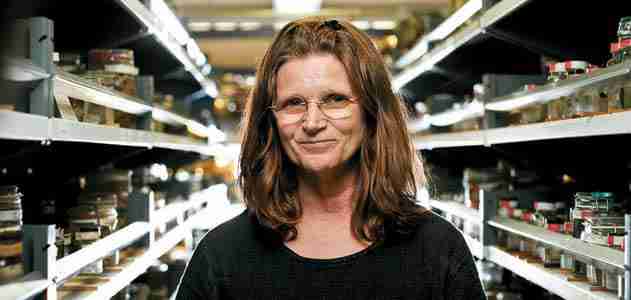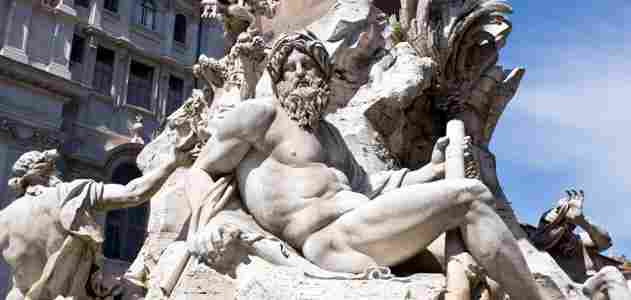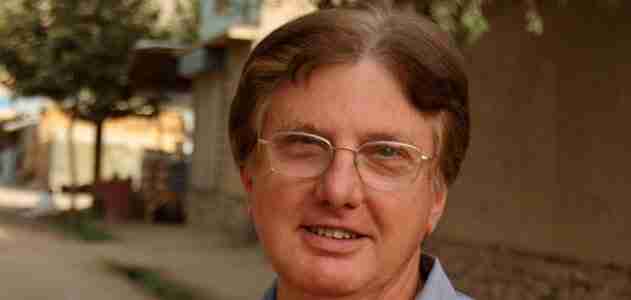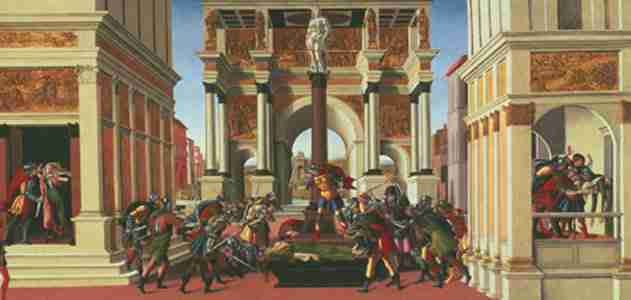Nancy Knowlton

Renowned coral reef biologist Nancy Knowlton was recently appointed to the Smithsonian's Sant Chair for Marine Science. She will lead the Institution's effort to foster a greater public understanding of the world's oceans. The magazine's Beth Py-Lieberman spoke with her.
Can you start by giving a short primer on how a coral reef grows and sustains itself? Coral reefs are created by corals and also by some other organisms—sometimes sponges, sometimes stony seaweeds. But corals are the main builders of coral reefs and they’re basically simple animals, rather like sea anemones. Each one has a little cup with a mouth and a ring of tentacles. They live in large colonies. The living part of the reef is just a very thin surface. Underneath is a skeleton which is secreted every . . . , well constantly, so that over the years, and decades, and millennia, you wind up with these massive structures that you can see from space. So a reef is sort of like a city; in the sense that it is always being constructed by living corals. But also, a reef is always being destructed by things that eat and chew on the rock, or turn the rock into sand. It’s always a balance between growth and erosion. What threatens coral reefs today? One culprit is overfishing, which wipes out a lot of herbivores. As a result, seaweed grows and smothers the corals. The second is declining water quality, caused by toxic materials and fertilizers that run off the land. The third is greenhouse gas emissions—especially carbon dioxide, which not only make the oceans too warm for reefs but also change the chemistry of the water, making it more acidic. And the more acidic the water, the harder it is for corals to deposit the skeletal structures that form the bulk of the reef. It’s sort of like when you’re mother told you not to drink so much Coca-Cola because it would dissolve your teeth. It’s the same kind of principle. That acidity, that increasing acidity, is making it much harder for corals to lay down a skeleton and it makes it, the skeleton, much more likely to dissolve in the future. So those are the three big ones: over fishing, poor water quality, and carbon dioxide because of its affect on temperature and acidification. Are these changes a death knell?
We’re on a very serious downward trajectory for corals. In the Caribbean alone over the last three decades we’ve lost 80 percent of all corals. This is a level of destruction that rivals the devastation of tropical rain forests. We use to think the pacific was in better shape because it’s so much bigger and in so many places the density of human population was not so large. But it turns out that even in the Pacific, most reefs are, they are not as bad as the Caribbean yet, but a lot of them have degraded substantially, actually, to quite serious levels. So it means that globally things are already bad and then we have this projection of future increases in carbon dioxide emissions, which are extremely worrying for the future health of reefs. If people don’t change the way they’re doing things, reefs as we know them will be gone by the year 2050. It’s actually really depressingly unbelievable. What would the world be like without coral reefs? About a quarter of all marine species live on coral reefs. These species are a source of food, tourism income and potential biopharmaceutical products, including cancer drugs. Reefs also provide incredibly important shoreline protection against hurricanes and tsunamis.
A dead coral reef will protect it for a while, but because of what I said about reefs being in a sort of process of building and eroding, a dead reef actually will erode away to sand. While snorkeling at a coral reef, say in the Florida Keys or the Hawaiian Islands, you’re likely to see a lot of different fish species. Does that mean the reef is a healthy, thriving one? That’s actually an interesting question. And it’s a hard question too.. Sometimes you can have reefs that appear to have lots of things swimming around them, but the underlying corals are in poor condition. They are sick and dying. That means things superficially look good now, but the longer-term projection is much worse. On the other hand, sometimes things that have lots and lots of diverse organisms swimming or crawling around are, in fact, healthy reefs. A recent study indicated a certain type of fish is necessary for good health. It is the presence of the fishes that eat seaweed. Not all fish eat seaweed. So you can have lots and lots of fish, but if you selectively removed the seaweed eaters, it is not be good for corals. Usually when people fish, they usually start with big predators, so you lose the big fish—the sharks, the groupers and snappers, and you tend to lose the big herbivores. It’s called fishing down the food chain so you get to smaller fishes. It’s not so much the diversity of the fishes that you want to look at, as the number and size of the fishes that play critical ecological roles. Yes I’ve been on a reef that has a green sort of slimy quality. What’s going on there? That occurs because of either over fishing, poor water quality, or both. Reefs are more sensitive to the removal of seaweed eating fishes than they are to poor water quality. You wind up with too much seaweed if you have lots and lots of nutrients coming in and not enough fish taking the seaweed out. So it’s a kind of a balance. Either one of those processes can have bad affects on reefs. Reefs tend to be very sensitive to over fishing in contrast to water nutrients, which will have an impact but you have to have a lot of nutrients in order to see that affect. So it could be either of those two things or a combination of them both. Should we even be snorkeling on reefs? Is that a problem?
I think we should be snorkeling and swimming on reefs. Because I think people only develop a passion for protecting things if they know what is at risk. I would hardly be one to say that we shouldn’t go near them. That said, its important to manage tourism properly. If you have a lot of people going onto reefs, stepping on reefs, collecting things from reefs, breaking corals off, or throwing anchors on top of reefs, that’s not good. It’s important to properly manage the numbers of people and their behavior when they’re in water. It’s also important to make sure that the hotels that support that tourism have good water treatment for the sewage that they release, and that they aren’t also feeding this large population of visitors critically important reef fish. That is ecologically sound tourism. But you can’t just let it develop willy-nilly. It has to be managed carefully. Otherwise, you end up with lots of people and not much reef. What would a thriving coral reef look like? A thriving coral reef has lots of living coral, often lots of three-dimensional structure, also a certain amount of pink stony material, which is actually a kind of stony seaweed actually, but it provides the surface that baby corals like to settle on. We like to see a lots of baby corals in places. Corals die just like other organisms, so you wind up with lots of empty spaces on reefs. But you want those spaces to be rapidly colonized by the next generation of corals. I’ve worked on a place in the middle of the central pacific called Palmyra Atoll and next to it is Kingman Atoll. They are protected by the United States as marine sanctuaries. When you go swimming on those reefs, 80 percent of that biomass is actually sharks and groupers. So we tend to think of a pyramid where there are lots of plants and then a smaller number of things that eat plants and a smaller number of things that eat those and then the top predators being the smallest of all. But it turns out that in the ocean what you have naturally is an inverted pyramid. It’s because the plants on reefs tend to be very small and have a rapid turnover. They’re not like very slow growing ancient trees. There are all these tiny things that are growing constantly and so turning over very, very fast. So as a consequence, you have more biomass at the top of the food chain with these big predators and less at the bottom. So you wind up normally with an inverted pyramid. We never see that because we’ve eaten everything at the top. For a completely pristine coral reef the fish community is dominated by top predators, things that are, you know, our size. There are very few places on the planet that you can see that because in most places the top predators are gone. Can scientists even say what constitutes a healthy reef? Or has degradation been going on so long that a truly thriving coral reef hasn’t every really been observed our time? The places that I was talking about where we saw those food webs dominated by top predators also had very lush coral reefs. They are far from people, or it is because for long periods they’ve been in protected areas—in those kinds of places, its still possible to see healthy reefs. And they give us a lot of hope in knowing that all is not lost and that there’s something we can do. I detect a ray of hope, but I hear they call you Dr. Doom and your husband, Jeremy Jackson, also a renowned marine scientist, Dr. Gloom. Jeremy and I, both, talk about the fact that we’ve lost 80 percent of the living coral on Caribbean reefs. And we’ve lost a lot of coral in the Pacific. And if we don’t change our ways, as humans, operating on the planet, we will lose all reefs. So it’s hard. You can’t just be cavalier. I mean we’re heading towards a catastrophe if we don’t change the way we manage the planet. And that’s not just coral reefs, its ocean resources in general. That said, we haven’t completely ruined the planet yet. And there are places on the planet that show us that it is possible to have healthy ecosystems with the right kind of management. So you can be optimistic in the sense that it is possible, but I mean, it is depressing to have watched. My husband is a little older than I am, and in the course of our professional careers, all the places that we have studied have essentially vanished as healthy reefs. It’s hard not to be Drs Doom and Gloom. On the other hand there is no point in that approach because everyone will say, “Oh well, what the hell, we’ve lost coral reefs.” And give up hope. So I think you have to make people realize just how incredibly serious the situation is, but also that there’s something that they can do about it. If a Genie granted you three wishes, what would you wish for? They’re kind of related wishes. One wish is that people would change their patterns of fossil fuel usage so we can get Co2 emissions capped and declining. If we don’t do that, in the long run, everything is hopeless. We have to do that. Reefs can’t grow in the level of acidity that is projected for business-as-usual Co2 emissions. Second wish is that we figure out ways to incorporate on a local level, sustainable agriculture, water quality treatment, and marine protected areas, so that we have conditions that favor reef growth. And then a more generic wish is that people would really, passionately, appreciate, and protect, the biodiversity of the planet, not just on coral reefs but the world at large.


Bernini’s Genius

Gian Lorenzo Bernini was said to have been only 8 when he carved a stone head that "was the marvel of everyone" who saw it, according to a contemporary biographer. He was not much older when he dazzled Pope Paul V, who reportedly declared, "We hope that this youth will become the Michelangelo of his century." Prophetic words: over a long lifetime, Bernini undertook commissions for eight popes, transforming the look of 17th-century Rome as Michelangelo had helped shape Florence and Rome a century before. Much of the Baroque grandeur of the Eternal City—its churches, fountains, piazzas and monuments—can be credited to Bernini and his followers.
Yet, despite his artistic stature, Bernini is only now receiving his first major American exhibition—at the J. Paul Getty Museum in Los Angeles (through October 26) and then at the National Gallery of Canada in Ottawa (November 28, 2008-March 8, 2009). One explanation for the oversight is obvious, says Catherine Hess, associate curator of sculpture and decorative arts at the Getty and a co-curator of the exhibition. "How do you move Piazza San Pietro?" Like that grand piazza, which Bernini designed in front of St. Peter's Basilica in the Vatican, the enormous marble sculptures for which the artist is best known are for all practical purposes untransportable. What does that leave? As it happens, a significant body of work: especially the portrait busts, a genre in which the young Bernini demonstrated that he was head and shoulders above the competition. "All the things that make Bernini great can be found in his portrait busts," says Hess.
By mid-career, as he became busier with large-scale ventures, Bernini did fewer busts—"only popes and kings, people you couldn't say no to," says exhibition co-curator Andrea Bacchi, professor at the University of Trento in Italy. But Bacchi believes one reason that the sculptor stopped doing busts after he got successful is that he valued them too highly to allow his assistants to take over the carving. By focusing this exhibition on portrait busts—including rare Italian loans that come as implicit thanks for the Getty's agreement last year to return some 40 antiquities said to have been excavated and exported illegally—the curators present a Bernini retrospective that is both intimate and revealing.
Bernini's prodigious output was the result of his skill at organization and his tireless self-discipline. He said that if he put together all the hours he spent on meals and sleep in his lifetime, he doubted whether they would add up to a full month. (A slim, dark-complexioned man who avoided the sun for fear of migraine headaches, Bernini typically ate only a small plate of meat and a large quantity of fruit each day.) At a young age, he was already managing a supporting cast of talented assistants. And he himself would labor for seven hours without interruption on a block of marble. According to a friend's description, the sculptor could carry on a lively conversation about the topics of the day, all the while "crouching, stretchingarking the marble with charcoal in a hundred places, and striking with the hammer in a hundred others; that is, striking in one place, and looking in the opposite place." Often Bernini proceeded without a terra-cotta model and sometimes even without a subject in front of him, realizing a vision that resided in his mind.
Indeed, he was a highly original thinker, not merely a consummate craftsman. In the many different arts he pursued—sculpture, architecture, painting, even playwriting—his works expressed ideas. Behind every Bernini masterpiece there lies a concetto, its governing concept or conceit. One concetto that fascinated the sculptor throughout his career was the attempt to overcome the limitations of his materials. When he was carving white marble, for example, he tried to suggest color: fashioning the eyes in his portrait busts, he would incise the irises deeply so that they lay in shadow and appeared dark. Even more ambitiously, he sought to imbue cold, inanimate stone with warmth, movement and life. Instead of positioning the subject of his busts straight on, he might have the head turning to the side or the fabric of the garment askew. In a number of his best sculptures, he pioneered what has been called a "speaking likeness," capturing a person in action or at the point of uttering words. He explained to an associate that "to make a successful portrait, one should choose an action and attempt to represent it well; that the best time to render the mouth is when [the subject] has just spoken or is just about to begin speaking; that one should try to catch this moment."
Cardinal Maffeo Barberini (later Pope Urban VIII) was once part of a group admiring a new Bernini bust (above left) of Monsignor Pedro de Foix Montoya—sharp-cheeked, furrow-browed and thick-mustached—when the monsignor himself entered the room. Barberini went up and touched the priest and said, "This is the portrait of Monsignor Montoya," then faced the marble bust and declared, "And this is Monsignor Montoya."
In his long career, no modeling job was more important to Bernini than fashioning his own image. "He wanted to create a legend around himself," Bacchi says. Recent scholarship reveals that the two seminal and supposedly independent biographies of the artist, begun toward the end of his life (one by his son Domenico), relied on information that Bernini himself supplied. And much of that he may have doctored. Many historians, for instance, believe that Bernini shaved a few years off his age when recounting the tale of the marvelous stone bust he claimed to have carved at age 8; he was probably in his early teens. Pope Paul V's comparison of Bernini to Michelangelo was another notion that the sculptor vigorously promoted. "If it isn't something that he invented, which he may have, it is something that he fostered very much in the later years of his life," says Tod Marder, professor of art history at Rutgers University. "Bernini was very familiar with the accounts of Michelangelo. He used that familiarity in cobbling together an account of his own life and career." Consequently, as Bacchi observes, "it is a strange fact that you know so much about the life of the artist from the artist himself, but you have to double-check everything."
At the time of Bernini's birth, in 1598, painting was the exciting art form in Rome—especially the new and startling realism of Caravaggio. Sculpture had become the domain of a worn-out Mannerism, replete with formulaic affectations and exaggerations. Bernini's father, Pietro, was such a sculptor. Of Tuscan origins, he had moved to Rome from Naples with his Neapolitan wife, Angelica Galante, when Gian Lorenzo was about 8. Ruled by the popes, who were constructing lavish churches and monuments, Rome was the place for a sculptor to find work.
Pietro encouraged his gifted son. When a visitor to his studio asked if he felt threatened by the prospect of his child surpassing him, Pietro replied, "It doesn't bother me, for as you know, in that case the loser wins." Among the powerful and well-connected art connoisseurs who recognized the boy's talent was Cardinal Scipione Borghese, who commis-sioned four colossal marble statues from him— Aeneas, Anchises, and Ascanius Fleeing Troy; David; The Rape of Persephone; and Apollo and Daphne . These established Bernini, in his early to mid-20s at the time, as the city's pre-eminent sculptor, and they continue to dazzle present-day visitors to the Villa Borghese, the cardinal's palatial Roman residence, now a museum.
With his David , Bernini took a subject that other great sculptors had tackled before him and made it his own. Instead of depicting the victorious warrior with the head of Goliath (as Florentine sculptor Donatello had done), or (like Michelangelo) showing the coolly confident youth before the battle, Bernini chose the most dramatic moment—when David is about to let fly the stone from his taut slingshot. Bernini's method was to seize and freeze the revelatory moment; he positioned his statues against walls, so that a spectator would take in the work from a prescribed perspective. With the David , you were meant to stand facing the young warrior, as Goliath did.
In his sculpture of the mythological Daphne, who was transformed into a laurel tree by her father to elude the unwanted attentions of Apollo, Bernini showed Daphne's skin changing to bark, her toes elongating into root tendrils and her fingers sprouting leaves, just as the lustful Apollo, his prize in his grasp, begins to realize what is happening. The Apollo and Daphne is a jaw-dropping feat of virtuosity. "In my opinion, not even the ancients did anything to equal it," Bacchi says. The roughness of the bark, the translucence of the leaves, the nymph's flying tresses—all are carved with such exquisite specificity that, once again, it is easy to overlook the audacity of the concetto. The process of metamorphosis was a subject for painters, not something to show by chiseling and drilling hard stone. And yet, wasn't metamorphosis a sculptor's task? Carving a block of stone into a lifelike form could be seen as a supernatural—even divine—feat.
When he finished the sculpture, according to his first biographer, Filippo Baldinucci, Bernini "attracted everyone's eye" and was pointed out in public. Yet he wasn't, in truth, personally responsible for the work's most acclaimed features. As Jennifer Montagu, a co-curator of the exhibition, has written, Bernini focused his efforts on the main figures—and the concetto. The execution of the roots, branches and hair tresses in this sculpture was largely the work of his assistant, Giuliano Finelli, who bitterly resented the lack of credit and went on to have a successful independent career. (Finelli's own work is also on display in the Getty show.) Finelli maintained a lifelong attention to minute detail. Bernini's work, however, was about to enter a new phase.
In 1623, Barberini, his friend and patron, was elected Pope Urban VIII. As Bernini's son Domenico relates, the new pope summoned the young artist to his side. "Your luck is great to see Cardinal Maffeo Barberini Pope, Cavaliere," he said, "but ours is much greater to have Cavalier Bernini alive in our pontificate." For the 20 years of Urban VIII's tenure, Bernini enjoyed unparalleled access to Urban and an abundance of papal commissions—not only sculptures, but entire architectural environments.
His most ambitious project was for St. Peter's interior. From 1624 to 1633, he designed and oversaw the construction of a massive bronze baldacchino , or canopy, above St. Peter's tomb. Traditionally, a tomb of this importance would have been covered with a small temple-like structure. Instead, Bernini fashioned four twisting columns as posts, which he topped with something that resembled a bed or processional canopy. Slender, leafy branches climb the columns, and from the roof, clothlike panels and tassels hang—all in bronze. "People at that time used to make ephemeral decorations out of paper and have them look monumental," Bacchi observes. "Bernini did monumental works that look like ephemeral works."
The imposing piazza that Bernini laid out in front of St. Peter's about a quarter of a century later, at the direction of Pope Alexander VII, is bordered by a free-standing, grandly curved double colonnade that he said was meant to represent the motherly arms of the church. Within the basilica, the contemporaneous Cathedra Petri , or throne of St. Peter, rivals the artist's earlier baldacchino—both for the elaborate gilded bronze sculptures produced by his studio and for its drama, provided in part by the golden light that pours through a yellow stained-glass window above it.
Bernini spent his entire adult life in Rome and, not surprisingly, he was chauvinistically Roman. His only known absence from the city was a trip to France in 1665, when he was invited by King Louis XIV to design an addition—ultimately rejected—to the Louvre royal palace. Throughout his time in France, he complained. All of Paris, he said, was worth less than a painting by the Italian artist Guido Reni. He compared the chimney-dotted city skyline to a wool-carding comb and characterized the royal palace in the Tuileries as "a big little thing." He complimented the architect François Mansart but noted how much greater he might have been had he lived in Rome.
Having rendered the grand-scale illusions of the Borghese statues and the Vatican commissions, Bernini was after something subtler when he returned in the 1630s to doing the portrait busts that he had first undertaken as a youth. "When Bernini came back to sculpture, it was not so virtuosic, not so many fireworks," says Bacchi. "He tried to capture life in a more synthesizing way—not to capture every detail but to give the impression of life."
A prime example is the bust he made of Scipione Borghese in 1632, generally considered one of the great portraits in art history. The sculptor portrayed the prelate's fat jowls and neck, the pockets around his eyes and the quizzically raised eyebrows (below) in such a lifelike fashion that one comes away with a palpable sense of what it would have been like to be in the prelate's presence. His head turned slightly to the side, his lips apart—is he about to share some titillating gossip?
Even more extraordinary is the bust that Bernini completed in 1638 of Costanza Bonarelli, the wife of one of the sculptor's assistants and also Bernini's lover. When he discovered she was also having an affair with his younger brother, Bernini—known for an explosive temper—reacted violently, attacking his brother and sending a servant to slash Costanza's face with a razor. What ultimately happened remains unclear, but Bernini was fined 3,000 scudi (a huge sum at a time when a sizable house in Rome could be rented for 50 scudi a year). The scandal caused Urban VIII to intervene and more or less command Bernini to settle down and marry, which he soon did, at age 40, in May of 1639. His wife, Caterina Tezio, the daughter of a prominent lawyer, would bear him 11 children, 9 of whom survived. Now ultra-respectable, he attended daily Mass for the last 40 years of his life.
Bernini's bust of Costanza is a work with few precedents. For one thing, women were not usually sculpted in marble unless they were nobility or the statues were for their tombs. And in those sculptures, they were typically portrayed in elaborate hairdos and rich dresses—not depicted informally, as Bernini had Costanza, clad in a skimpy chemise with her hair unstyled. "He takes out all the ornaments that were important to the 17th-century portrait and focuses on the person," says Bacchi. "You see a little of her breast, to think she is breathing, the crease of her neck, so that she seems to be moving." The portrait engages the viewer so intensely, Bacchi adds, "because it is just her expression, there is nothing to distract you." With her mouth slightly open and her head turned, Costanza is radiantly alive. In another way, too, the bust is exceptional. Marble was expensive. Bernini's portrait of Costanza is thought to be the first uncommissioned bust in art history made by the sculptor for his own enjoyment.
In a career that continued until paralysis stilled his hand shortly before his death, at 81, in 1680, Bernini enjoyed almost uninterrupted success. His only serious setback came in the 1640s, when the death of Urban VIII brought in a new pope, Innocent X, who favored Bernini's rivals, including the architect Francesco Borromini and the sculptor Alessandro Algardi. A high-profile architectural project for Bernini to add two bell towers to St. Peter's was canceled, requiring an already constructed tower to be torn down. But even Innocent X could not gainsay Bernini's talent. When the pope was commissioning a new fountain for the Piazza Navona, Bernini, uninvited, composed a model for it. Innocent X was brought into a room that contained the model and he was smitten. "The only way to resist executing his works is not to see them," he reportedly said. Featuring an obelisk, which seems to rise unsupported from a rough outcrop of travertine, around which real flowing water and muscular figures of marble disport, the Fountain of the Four Rivers is a city landmark to this day.
Bernini was always after the maximum theatrical impact. Indeed, along with his other talents, he was also a professional dramatist. In one of the plays that he wrote, he made a wall of water rush at his audience, diverting it through sluices at the last gasp-inducing moment. Another one of his offerings combined two plays proceeding simultaneously on a stage divided by a scrim and watched by two separate audiences; the stories cleverly interlocked, and each side was expected to overhear the other.
To a modern sensibility, Bernini the sculptor at times can seem too much the showman, rummaging through a bag of tricks to please his audience. He lived long enough to hear such criticisms. Notwithstanding his enormous celebrity (crowds gathered along his route to France in 1665, as if, the artist said, he were an elephant), he correctly predicted that his reputation would wane over time.
This pessimism may explain why Bernini was so intent upon stage-managing his biographies. It could also shed some light on one of his most renowned achievements, The Ecstasy of St. Teresa , which he executed for a side chapel in Rome's Church of Santa Maria della Vittoria from 1645 to 1652, and which he called his most beautiful creation. At its center is the white marble sculpture in which Teresa, convulsed in ecstatic pain, yields to an angel about to pierce her with the golden arrow of divine love. On either side of Teresa, Bernini placed a box with seats, of the kind found in theaters, containing four men. But in each box, only the man closest to Teresa looks at her. The others are chatting or, in one case, reading a book. Could Bernini have been anticipating a future in which his achievements would be similarly ignored? If so, he would be heartened to see his exuberant genius once again receiving its due.
A frequent contributor, Arthur Lubow is based in New York City. He wrote about the arts and culture of Bhutan in March 2008.
David DeVoss on “Macau Hits the Jackpot”

David DeVoss is a journalist who spent more than a quarter century working for Time , The Los Angeles Times and Asia, Inc. , a Hong Kong business magazine. He currently operates a print media company called the East-West News Service and the website US-China Travel News .
What drew you to this story? Can you describe its genesis? I spent a lot of time in Macau during the late 1970s when I was a Time Magazine correspondent in Hong Kong. When Sheldon Adelson and Steve Wynn won Macau gaming concessions in 2003, I wrote a story for Asia, Inc. on how western investment could revitalize the crime-plagued city. One Sunday morning in December 2006 I opened the newspaper and read that Macau gaming revenues exceeded those of the Las Vegas Strip. By the time I suggested the story, Macau's revenues had surpassed the State of Nevada. When I finally arrived in Macau, gaming revenues were expected to top Nevada and Atlantic City combined by 2012.
But this story's not about gambling. It's about the most visible manifestation of modern China and the incredible wealth it is generating.
What surprised you the most while covering Macau? That in less than a decade Macau has gone from a crime-infested backwater with high unemployment to a vibrant city that is poised to become the entertainment capital of Asia. Also the lingering influence and civic involvement of the 3,000 Portuguese that continue to call Macau home.
What was your favorite moment during your reporting? My fifth night in Macau, I was invited to a wine tasting at the residence of Portuguese ambassador Pedro Moitinho de Almeida. He lives in a beautiful colonial structure at the tip of the peninsula that once was the Bela Vista Hotel, where I often stayed during reporting trips for Time . My date for the evening was Maria Helena Rodrigues, head of Portugal's Orient Foundation. After the reception, we walked down to her apartment just below the Bela Vista and stood out on the terrace. Thirty years before, I stood above the terrace on the veranda of the Bela Vista watching bat-winged fishing junks sail down the Pearl River. Now the view was dominated by soaring suspension bridges, man-made lagoons and the Macau Tower.
Do you think the development of the gambling industry has helped or hurt Macanese culture? The Macanese culture has a bright future because of the economic prosperity resulting from gambling.
Was there anything fun or interesting that didn't make the final draft of the story? There are more Chinese studying the Portuguese language today in Macau than there were when Macau was a Portuguese colony. Why? Because China is desperately searching for natural resources to sustain its booming economy and Macau has become China's doorway to the resource-rich—and Portuguese-speaking—nations of Brazil, Angola and Mozambique.



Post a Comment